Sometimes, people, comics come out that I
think you
should buy. Then, sometimes, comics come out that I
warn you
not to buy (not often, because I usually drop those quickly, but occasionally I buy a clunker). Then, sometimes, comics come out that you
must buy
to save your very souls. A few of those came out this week, among a pretty strong crop of books. And I get to rant again with visual aids! Won't that be fun!
Before we go on, I must warn everyone that today's post
WILL contain images that are definitely
NOT SUITABLE for children or uptight employers (or uptight people in general). Kids, go play Grand Theft Auto or something wholesome like that. Workers of the world, watch your backs - those who control the means of production may take offense at you gazing on such shocking images!
Action Philosophers! World Domination Handbook (issue #4) by Fred van Lente and Ryan Dunlavey
$2.95, Evil Twin Comics
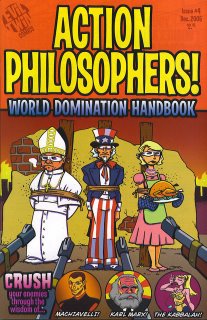

Many people (including me) have lauded the first three issues of this series until we couldn't laud no more, so I'm sure you all ran out and purchased this yesterday to soak in the philosophical goodness. If you didn't, I fear for you. No, not from reprisals by me, although I would be completely justified. I fear that when you die and stand before St. Peter, he's going to ask you just one question: "Did you ever buy an issue of Action Philosophers!?" If you say yes, you get into Heaven with all the 72 virgins (I may have stolen that from somewhere). If you say no ... Well, let's just say someone else will be playing the role of virgin ...
People, people, people. In this, the latest issue of perhaps the most essential comic book ever, van Lente (for whom Cronin has a serious man-crush) and Dunlavey take on Marx (as a M60-wielding Rambo wannabe), Machiavelli (who is shown only in silhouette) and the Kabbalah (and you should buy it for the Britney Spears-giving-birth panel alone). As usual, our creative heroes give us plenty of factual information about the philosophers, while sprinkling the narrative with laugh-out-loud jokes and sly comic references (Pope Julius II leading a Renaissance Justice League is nice). There's simply far too much excellence in this comic to describe it all - I could go through almost every panel and find something worthwhile. The Marxist film teacher get bayoneted by the young Fred, who shouts, "Die, tool of the oppressors! Die!!" is just a random example of goodness. See? I fear for your eternal soul. Put down that issue of Sensational Spider-Man and pick this up!
Bomb Queen #1 by Jimmie Robinson
$3.50, Image
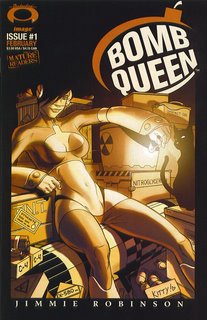

And then there's Bomb Queen.
Here's what's good about Bomb Queen. It's certainly interesting. The lead character is completely amoral, which makes her fascinating to a certain extent. For those of you who haven't heard about it, Bomb Queen took over Newport City ten years ago and killed or drove off all the heroes. She's still running the place, and a new candidate for mayor hires a hero to come in and take her out. The most interesting thing is that the people don't seem to mind that she's in power. They are fascinated by her celebrity, think her "take-no-prisoners" attitude is cool, and are happy to live their lives with the knowledge that someday they might come to a gruesome end, probably as collateral from one of her random bombs. It has a lot of potential to satirize America's celebrity culture and how far we will go for entertainment. On that level, it's a success.
Here's what's bad about Bomb Queen. First, a minor thing: I didn't like the lettering. Lettering should be like referees or umpires: they're good if you don't notice it (Seattle fans know what I'm talking about). This lettering is ugly:


However, that's a minor issue compared to the bigger issue: I feel like I need to wash my hands after reading it. Maybe Robinson wants us to be uncomfortable after reading it. But if he does, I suspect he wants us to be uncomfortable because of the parallels I was talking about in the previous paragraph. In a text piece at the end of the book, he certainly wouldn't mind if you thought that way about the book. However, it just made me feel icky reading it.
A great deal has already been made about Bomb Queen's outfit. It's so over-the-top, however, that I feel that Robinson is completely satirizing mainstream comic book costumes, much like Morrison and Giffen did in that Doom Force Special from the early 1990s. You see her costume on the cover. Here's a better look at it:
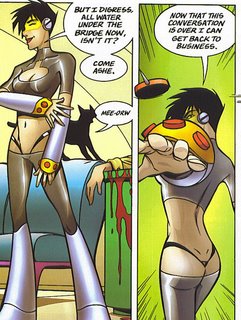

Yes, it's stupid. Yes, it defies the very laws of physics! But, unlike Daughters of the Dragon, I get the feeling it's meant to provoke a reaction from people, who will then declaim loudly how horrible it is, which will push up sales. Robinson is having some fun with us, and although I don't find it terribly funny, I can forgive him.
Actually, a problem I have with the book is that it's not gratuitous enough! How can I say that? Well, it's for "mature readers."¹ Fine. Curses fly from Page One. Dandy. Bomb Queen wears that ridiculous outfit. Then she goes home and takes a bath while watching television, which is a nice sequence because it ties in with that critique of celebrity culture I mentioned. But then we get this bizarre two-panel sequence:
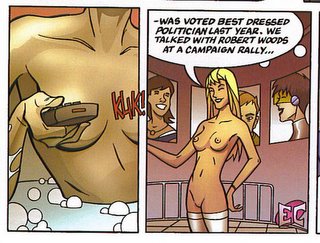

Robinson deliberately and awkwardly obscures the nipples of his heroine a panel before he shows a completely naked woman. What the crap is up with that? Notice anything else strange? Let's zoom in on that completely naked woman:

Is she a robot? How will she ever have children? That's just weird.
So let's get this straight: a "mature readers" book, clearly labeled, can have curses flying left and right, the mutilation of an elderly secretary, Bomb Queen wearing that ridiculous outfit, nipples aplenty on others, but we can't see Bomb Queen's nipples or (won't someone think of the children?!?!) labia. That's just stupid. Put a thong on her if you're not going to have the balls to go all the way.
Oh, and Robinson's text piece at the end smacks a little too much of self-congratulations for being such a rebel. If you're such a rebel, Mr. Robinson, don't censor the nudity.
Phew. That was fun, wasn't it? Despite this, I rather liked Bomb Queen. At least enough to recommend it. It may make you angry, though.
DMZ #4 by Brian Wood and Riccardo Burchielli
$2.99, DC/Vertigo


I said I was dropping this after last issue, and I still am, but I think this may have been the only copy my comics shop ordered, so I felt kind of guilty about it, so I bought it. What the hell, right? It's not bad, just like the first three issues, but it's not great, also just like the first three issues. It's a stand-alone story in which Matt heads to Central Park and stumbles across a group of ex-Special Forces guys who have transformed the Central Park Zoo into their own little compound. These "ghosts" of course deny who they are, but they're not fooling anyone, least of all Matt. It's an interesting issue because these guys aren't just killers - they can kill, of course, but they're growing bamboo to barter because everyone has chopped down the trees, and they are taking care of the animals and using solar power. It's an interesting glimpse into how life might be like in the war zone - the first three issues showed us a different glimpse, and one that was more stereotypical, in my mind. The ghosts get in a gun fight with a roving band of tree-choppers, and one of the dying soldiers gives Matt the key to his mother's apartment, telling him it's secure. Presumably Matt will use this as a base.
Like the first three issues, it's certainly interesting, but it's just not grabbing me. Matt seems like way too much of a wuss, and the whole grand narrative just isn't all that compelling. I know I won't be getting the next issue, because I told the guy at my shop to stop getting it. So I'll say goodbye to DMZ for the second time. Goodbye.
Fables #46 by Bill Willingham, Jim Fern, and Jimmy Palmiotti
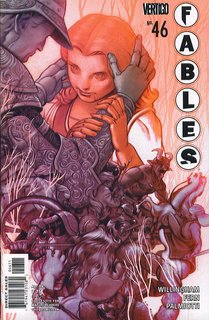

Holy crap, it's a Jim Fern sighting. Where has he been?
This is yet another good issue of one of the best titles out there - it's a two-issue "filler" story, but still serves to push the main narrative forward, at least a bit. It's the tale of a wooden soldier fighting in the front lines of the Arabian campaign, and he's writing a letter to Gepetto, whom he's never met, telling him about how he fell in love with a woodcarver, June. This presents a problem, as wooden people were not equipped to express their love - that's right, they're not anatomically correct! So Rodney (the soldier) asks Gepetto to turn him and June into humans so they can make the beasts with two backs. His commanding officer gets a hold of it and it displeased, and Rodney will face his fate next issue.
It's a relatively simple tale, but it shows again the thought Willingham has put into this world and its characters. Rodney and his cohorts are wooden men, but they aren't automatons. They look down on the "meat" soldiers, but Rodney soon realizes that the fleshy ones can do things even the wooden soldiers can't, despite the wooden soldiers' obvious superiority. The social commentary in the issue is interesting, as is the attempt by Rodney and June to hook up.
There's a lot going on in what could have been a simple fill-in love story issue. Which is why Fables is so good, of course.
Jonah Hex #4 by Jimmy Palmiotti, Justin Gray, and Luke Ross
$2.99, DC


Here's the problem I have with this book: Jonah isn't enough of a scumbag. Oh sure, we think he's a scumbag, but he's really not. I certainly don't mind if he saves the girl and rescues her beau and punishes evil, but it should be kind of by accident. So far in this series, he's done the right thing simply because it was the right thing. Take this issue: he does the right thing because he suspects the guy he has brought in is innocent, and a "chat" with the mute girl convinces him. So he does the right thing. Boo! He's in danger of becoming a softie. I want him to ignore the fact that the bounty he brought in is innocent, ignore the pleading of the comely lass, and do the right thing because the bad guy pisses him off. Or do the right thing because someone pays him to. Or ... you get the idea.
Don't get me wrong. I love the single-issue stories, I like the characters, I like the action, I like the art. But Jonah is too nice. What would Clint say????
Legends of the Dark Knight #200 by Eddie Campbell, Daren White, and Bart Sears
$4.99, DC


200 already? I remember getting the first issue signed by Denny O'Neil back in State College lo those many years ago ...
I wonder about Campbell's involvement in this. He's the co-writer, so I wonder if he was sitting around at a con somewhere and threw the idea out there and later DC ran with it. If he was involved in any more significant way, it's certainly a strange pairing - Campbell and Sears. It's a decent issue, too - not because it's that surprising when Batman crashes into the emergency room with the Joker in his arms demanding that they save him first - it's kind of obvious he needs the Joker alive for some reason - and not because of the location of the third bomb - that's also pretty obvious. What's decent about it is the portrayal of Batman and the portrayal of the "little people" around him.
See, the cool thing about this title, when it works, is that it's not about Batman, necessarily. It can be, but Batman has taken on such mythic status in Gotham City and in our minds that we see him as a archetype, not necessarily a human being. This is fine for short stories like this. We get very little insight into Batman; rather, we get insight into the citizens of Gotham and how they react to him. This has been done countless times, but for me, at least, it doesn't get old, because there are infinite reactions to Batman. Therefore, in this issue we get Natalie Koslowski, a rookie intern at Gotham General Hospital. How she handles the crisis perpetrated by the Joker and her reactions to Batman bringing a critically wounded Joker into the ER make this an interesting story. It's not revolutionary, but it's good, solid storytelling.
Sears is Sears. You either like his style or you don't. His work here reminds me of his work on The Path, especially the thin horizontal panels, packing a lot onto each page. His Batman is ominous and stoic, as he should be in this kind of story. And a Batman story in which our hero grins menacingly can't be all bad!
It's not worth 5 dollars, unfortunately, but it is a pretty good read. Convince your local comics proprietor to give you a dollar discount!
One of the punks Batman beats up uses the word "abseiling." Would a common street punk know this word? I'm just wondering ...
The Middleman Vol. 2 #1 by Javier Grillo-Marxuach and Les McClaine
99¢, Viper Comics


Okay. Here's your second chance. To all you people who bought Countdown to Infinite Crisis even though you knew it was going to suck, simply because it was a dollar and why the hell not? I give you The Middleman. Here's a comic that doesn't suck, will make you laugh, and is only 99 cents. So what's your excuse?
This is the second comic I bought this week that is good for your soul. I don't think you'll go to Hell if you don't buy it, but if you don't buy it, you may have no sense of humor. You might want to check. It's quite a bit funnier than the first mini-series (which has come out in trade paperback for $9.95 - in digest format - so you should look for that, too), and it has a little bit more character development. Not a lot, because, after all, it's a goofy comic, but a little. Wendy is settling into her role as sidekick to The Middleman - he fights evil so you don't have to! - and she's thinking about the more seemly parts of the job - like how much she gets paid. She starts thinking about it because her roommate has taken a job waitressing at "Hooters," and a girl's gotta eat! (This contains one of the many funny lines in the book: Wendy says, "When we graduated from art school, we swore two things: No more autoerotic asphyxiation boyfriends -" and her roommate says, "What was with those guys? We were like magnets." Comedy gold, people!)
The Middleman is bringing in Sensei Ping to teach her martial arts, but he's called away when a famous diamond is stolen. Wendy is left to pick up Sensei Ping on her own, and here's where the hilarity really ensues. Grillo-Marxuach is poking fun at all the wonderful ninja dudes we've seen over the years, and he does it so obnoxiously that it becomes more bizarre and funny with each thing Sensei Ping says. He's wearing a Mexican wrestler's mask, for crying out loud! When he calls Wendy's car a "soiled prophylactic with wheels," you know you've reached comedic nirvana. But it keeps getting funnier!
Seek this out, padawans. You won't be disappointed.
Tales Designed To Thrizzle #2 by Michael Kupperman
$4.50, Fantagraphics
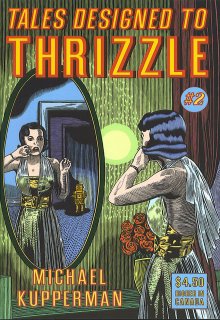

If you don't buy this, I fear for your soul. I also fear that we just can't be friends anymore. And I'm a great guy. Who wouldn't want to be friends with me?
I missed the first issue of this, and now I can't find it and I'm sad. So I snapped this up lickety-split, and you should too. You think Morrison's Brotherhood of Dada was Dadaist? You obviously haven't read a true Dada comic book. But Tales Designed To Thrizzle takes cares of that for you. It's so bizarre it would really be pointless to describe it. But it's howlingly funny. Sure, it's $4.50, but unlike Legends of the Dark Knight, it's worth every thin penny you slap down for it.
Each "story" is independent, and some are only a few panels long, while the longest is three pages. Kupperman throws so much wacky stuff at us that we can't ruminate on the insanity of, say, the Apiary Hat before we're thrown into the world of the Love Jumble! And then, just when we get a hankering for Merlin's Ham Banana Rolls, we discover how to recognize different kinds of trees and the criminals who hide behind them! If you want to know how to annoy large fish or keep bears from stealing your homework, then this is the book for you!
Have I convinced you yet? It has mentally ill gangsters!!!!
Ultimate X-Men #67 by Robert Kirkman, Tom Raney, and Scott Hanna
$2.50, Marvel
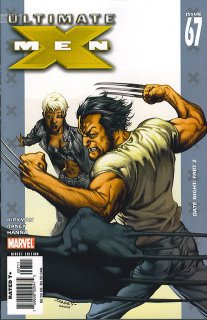

I read somewhere that Ultimate X-Men is just like the old Claremont Uncanny X-Men. That was a criticism. I say, hell yeah it's like that, and there's nothing wrong with that whatsoever! Every issue of this makes me appreciate good solid superhero comics. Kirkman has jumped into the pool with both feet - he has so much going on it almost leaves you breathless. Xavier, of course, is meeting with L. Ron Hubbard - whoops, I mean Lilandra Neramani - and he wants her money but he's suspicious of her "church" - and she doesn't help matters when she tells him what they worship. Meanwhile, Sabretooth has some revelations about Wolverine, Peter tries to re-connect with Kurt, Scott and Jean are trying to get it on, as are Rogue and Bobby. And of course there's that kid in the mansion who's parents are dead. Nick Fury wants to have a word with him.
This is just cool. It's just ... cool.
X-Men #182 by Peter Milligan and Salvador Larroca
$2.50, Marvel
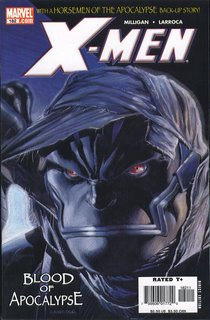

Speaking of cool, this is a cool cover. And guess what? This is a surprisingly good issue, given that Apocalypse is the star of the book. Milligan is leaving the book, and that's not the worst thing in the world, even though he writes some cool issues like this one. Apocalypse seems actually menacing, and the way he creates his Horsemen is nasty and perfect. Rogue finds out that Mystique's guy, lamely called Pulse, has a nifty talent. However, in the scene with the two of them, he puts his hand on her arm, which is covered by a sleeve (unless, of course, her skin is green). She expresses surprise that she hasn't stolen his powers. She's wearing clothes? What's up with that? Despite that minor glitch, this is a very good issue. Milligan invests characters like Ozymandias with far more personality than anyone else ever has (as far as when I've seen him), and we get to see Shiro, which is always nice. There's a strange back-up story that features Shiro in Apocalypse's stronghold while the bad guy works on Gazer. I say strange because although it's a fine story, I'm not sure why it wasn't incorporated into the main story. Oh well. This is a nice way to set up the big Apocalypse storyline. I'm scared it will suck in the end, because it is, after all, Apocalypse, but this issue gives me hope.
Mini-series I bought but did not read.
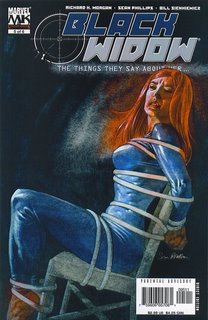
 A redhead dressed in leather tied up. Wow - we've never seen that before.
A redhead dressed in leather tied up. Wow - we've never seen that before.
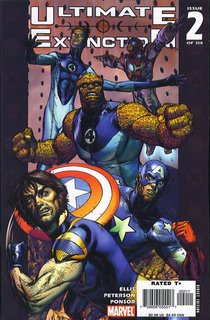
 As far as I can tell, only Captain America - out of costume - and Reed - for a couple of pages - appear in this book. Never mind scenes not appearing on covers, now we have most of the characters on a cover not showing up at all in the book. If that's true, they should have put Ultimate Werewolf By Night and Ultimate Sleepwalker on the cover. Now that would have been cool.
As far as I can tell, only Captain America - out of costume - and Reed - for a couple of pages - appear in this book. Never mind scenes not appearing on covers, now we have most of the characters on a cover not showing up at all in the book. If that's true, they should have put Ultimate Werewolf By Night and Ultimate Sleepwalker on the cover. Now that would have been cool.
So. Let's review. Buy Action Philosophers! or you will almost surely go to Hell (I won't say it's 100%, but I have e-mailed the Pope for confirmation), buy The Middleman or everyone might doubt if you have a sense of humor, and buy Tales Designed To Thrizzle or we might not be friends anymore. Are we clear?
¹ I'm sure someone has pointed this out before, but why are "mature readers" anything but?Read More
















